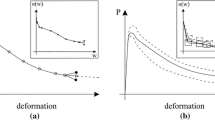Quantifying the residual stresses σ fr in tension is one of the most critical issues in the theory of steel-fiber-reinforced concrete (SFRC). The objective of this investigation is to determine the stress–crack opening relation of SFRC. An inverse technique is proposed for the determination of σ fr by employing experimental data from three-point bending tests on notched members. The nonlinear finite-element analysis program ATENA is utilized to verify the stress–crack opening relation obtained. A comparison of simulated load–crack tip opening displacement curves with experimental data attests to the adequacy of the inverse technique.





Similar content being viewed by others
References
I. Lofgren, “Fiber-reinforced Concrete for Industrial Construction — a fracture mechanics approach to material testing and structural analysis,” Chalmers University of Technology, Göteborg, (2005) ISBN 91-7291-696-6.
C. Pedersen, “New production processes, material and calculation techniques for fiber reinforced concrete pipes,” PhD thesis, Department of Structural Engineering and Materials, Technical university of Denmark, Series R, No. 14 (1996).
L. Vandewalle, “Cracking behaviour of concrete beams reinforced with a combination of ordinary reinforcement and steel fibers,” Mater. Struct. 33, 164-170 (2000).
G. Kaklauskas, V. Gribniak, and D. Bacinskas, “Inverse technique for deformational analysis of concrete beams with ordinary reinforcement and steel fibers,” Procedia Engineering, 14, 1439-1446 (2011).
RILEM. “RILEM TC 162-TDF: Test and design methods for steel fiber reinforced concrete, σ − ε design method. Final recommendation,” Mater. Struct., 36, No. 262, 560-567 (2002).
H. S. Armelin and N. Banthia, “Predicting the flexural postcracking performance of steel fiber reinforced concrete from the pullout of single fibers,” ACI Mater. J. 94, No. 1, 18-31 (1997).
P. Robins, S. Austin, and J. Chandler, “Flexural strain and crack width measurement of steel-fiber-reinforced concrete by optical grid and electrical gauge methods,” Cement and Concrete Research, 31, No. 5, 719-729 (2001).
Acknowledgements. The authors wish to express sincere gratitude to the Research Council of Lithuania (Project No. MIP–083/2012) for the financial support.
Author information
Authors and Affiliations
Corresponding author
Additional information
Translated from Mekhanika Kompozitnykh Materialov, Vol. 49, No. 6, pp. 1021-1028 , November-December, 2013.
Rights and permissions
About this article
Cite this article
Meskenas, A., Kaklauskas, G., Daniunas, A. et al. Determination of the Stress–Crack Opening Relationship of SFRC by an Inverse Analysis. Mech Compos Mater 49, 685–690 (2014). https://doi.org/10.1007/s11029-013-9385-8
Received:
Published:
Issue Date:
DOI: https://doi.org/10.1007/s11029-013-9385-8




